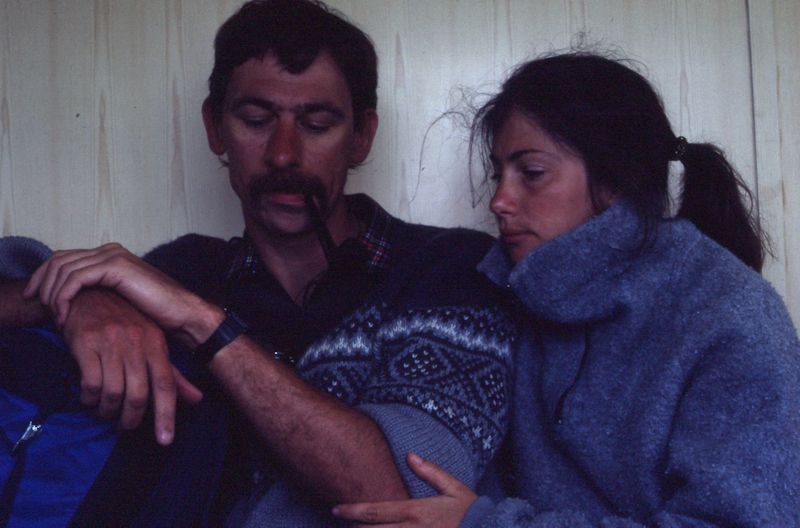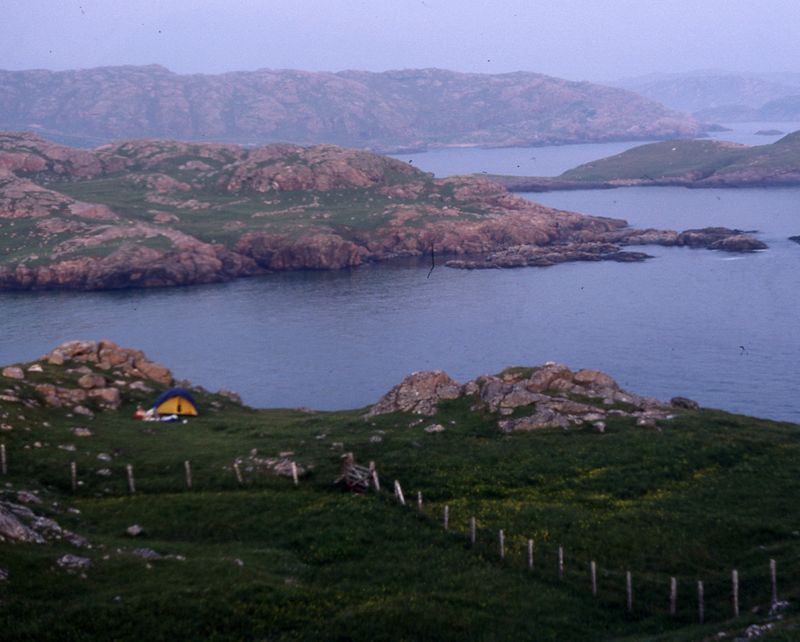|
 Dwight Peck's personal website Dwight Peck's personal website
Scotland
in 1983
In summer
1983, Mr Peck and traveling companion Jane set off on the first of many trips
to Scotland. Is Scotland a country? Or a province of England, or what? Never mind,
it's always wonderful, even when the fog's in and the mist is rising to meet it.
You
may not find this page tangibly rewarding unless you're included here, so this
is a good time for casual and random browsers to turn back before they get too
caught up in the sweep and majesty of the proceedings and can't let go.
Petrol
in the old Volkswagen Golf, a long road north through Germany, and the ferry from
the Hook of Holland to Harwich ("Haritch"), and then a leisurely drive
northward past all the fine old castles.

For example,
Castle Rising in Norfolk, England, seat of the Howards, Dukes of Norfolk in the
early days, here adorned by traveling companion Jane.

Jane
in the Castle Acre Priory in Norfolk. We're taking the scenic route northwards
towards Scotland, 1983.

And
Whitby Abbey, where the religious guys gathered to pray and make illuminated gospels,
etc.

Breaking
camp on the dunes near Bamburgh Castle, not far south of Berwick and the Scots'
border

Coastal
camp near Bamburgh Castle (on the horizon)

Crichton
Castle, something about Bothwell and Mary Queen of Scots hiding out, a fine faux-Italian
Renaissance tiled courtyard in the centre; traveling companion Jane does her Wyeth
impressions across the meadows.

Viewing
Dunnotar Castle, just south of Aberdeen, a wonderful former castle popularized
by hiding out the Scots' crown jewels in the 18th century nasty wars and providing
background footage of Elsinore in Mel Gibson's watchable version of Hamlet.


Travelers
pacing about and smooching in Dunottar Castle, waiting for the wardens to leave.

Drum
Castle, with cartwheeler, July 1983

Still
moving northward, a nice lunch by a peaty creek near Tomintoul and the 'Devil's
Staircase', just east of the Cairngorms, which would later become a favorite venue
for Peck sports.

Here's
Scrabster on the north coast -- if you want to go farther north in Scotland (unless
you're a petroleum engineer with free use of the corporate helicopter), you
catch the ferry here.

And
the ferry, still heading northwards, will pass the "Old Man of Hoy",
a seastack on the west end of Hoy of beautiful Orkney.

Stromness
on Mainland Island, Orkney, offers much in the way of the amenities we have come
to expect these days, including spiritual solace (see church steeple, centre),
but unfortunately not much in the way of modern bicycles. The rentals had only
one gear -- i.e., forward.

Moving 600 lbs of camping gear across Orkney's Mainland Island on a single-speed
bicycle, July 1983

What
do they do for fun? In the summer, blissful; in the winter, perhaps grim.

Tomb
Raider -- neolithic burial mounds on Mainland island, Orkney.

Standing
Stones on Orkney, the Brogar Ring -- the stones are still there, beautiful in
their own way, but the religion is long gone. Who knows what they mean?? Think
about the Cross in a few centuries. "Whoa,
a Christian Cross, cool photo. What do you 'spose it means?!"

One-speed
bicyclists with sore butts on Mainland Island, Orkney.

On
Lambholm Island, at 11 p.m., looking out for a good camping place. Lambholm is
one of several isolated islands around the Scapa Flow of Orkney, mostly uninhabited
but connected by the Churchill causeway, built by prisoners of war who were interned
there during World War Two. Scapa Flow was an important British submarine base
during the war.
| 
|

|
Camping
on the coast near midnight, July 1983

Seeking
the facilities, but there are none here.


Lambholm
Island -- the Postcard. Lambholm is the first island off the mainland, and our
camp near the Italian Chapel was at the leftward end of that.

The
Italian Chapel, Lambholm's claim to fame and a significant one. The chapel
was built on this now-uninhabitated island out of a tin Nissan or Quonset hut
by Italian prisoners of war in their spare time, using metal debris as it came
to hand, and creating a trompe d'oeil perspective effect. After the war it fell
into disrepair, but in the late 1970s Scotland sought out in Italy the surviving
members of the original team and brought them back to refurbish the original inspired
glory. As of 1983, the Italian Chapel sat out there on uninhabited Lambholm island,
with no fences or guards, a stupendous exemplar of lots of good things.

Orkney
ferry back to mainland north Scotland, July 1983

Preparing,
near Inverness, to set out on an inflatable-rim kayak trip through Scotland's
Great Glen, along the Royal Caledonian Canal, from Inverness to Fort William --
unfortunately, in the wrong direction, east to west
as the gale force winds continued blithely from west to east. A five-day trip
that probably could have been over in eight hours, going the other way.

But
with a welcome night camping under the parapets of Urquhart Castle, where all
the best Loch Ness monster sightings take place.

Heading
for the west coast near the ferry port of Ullapool, a superb far-northwestern
camp near Kinlochbervie just south of Cape Wrath.

Ullapool
at dusk -- terminus of the ferry to the Outer Hebrides

Following
a lively ferry ride out to the Russian fishing port of Stornaway in the Outer
Hebrides, at the north end of Scotland's Lewis and Harris Islands, the travelers
spent a couple of days walking southward through stunning countryside in inclement
weather, counting beer tins thrown by the roadside by locals still hoping to get
a decent job in London or at least Manchester. Counting by the bimbos pictured
on the tins, we had 42 Beverlys, 40 Anitas, 38 Jills, 37 Elizabeths or Beths,
36 Donnas, 34 Kerrys, and so on.
Having,
in the end, camped near Tarbert, the travelers met some fine older gentlemen in
the pub who insisted that Ronald Reagan (then the easily forgotten president of
the USA) needed to send troops to free Scotland from the English. And as the evening
grew longer, the fine gentlemen took the notion that I
was Ronald Reagan and began to grab at my lapels, shaking me and imploring me
to send the troops as soon as possible. Before the North Sea oil's all gone! They
also offered us lodgings in their loft, but luckily we'd already set up camp up
in the hills way off from the village. WAY off from the village!


Passing
back through the splendid Isle of Skye, the travelers visited Dunvegan Castle
in the northwest, where the charming McLeod of McLeod himself came down in his
off-the-rack kilt to show us round and suggest that we, like McLeods all over
the world, might like to contribute to pay for a new roof on the castle.

The
beautiful Cuillin Hills in early evening, 1983, in later years one of Mr Peck's
favorite running routes. According to the press, in the absence of significant
contributions to the new Dunvegan roof, the McLeod of McLeod is presently engaged
in trying to sell the Cuillin Hills to the highest bidder, since the lairds (having
thrown the peasant crofters off the land in the 18th and 19th centuries) can somehow
be seen to "own" whatever may remain. Environmentalists and mountaineers
are, understandably, arraying themselves on the other side as amici curiae.

Driving
south again, here's Caerloverock Castle south of Glasgow. Great moat, not much
else left. Who doesn't know the feeling??
 Feedback
and suggestions are welcome if positive, resented if negative, Feedback
and suggestions are welcome if positive, resented if negative,
 .
All rights reserved, all wrongs avenged. Posted 10 August 2003, revised 30 April
2008, 9 October 2014. .
All rights reserved, all wrongs avenged. Posted 10 August 2003, revised 30 April
2008, 9 October 2014.
|
 Dwight Peck's personal website
Dwight Peck's personal website


































